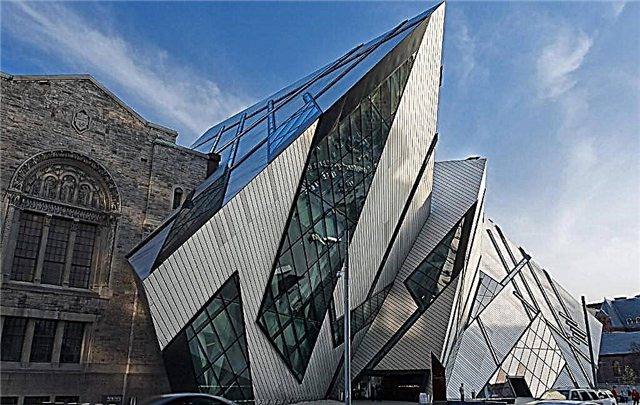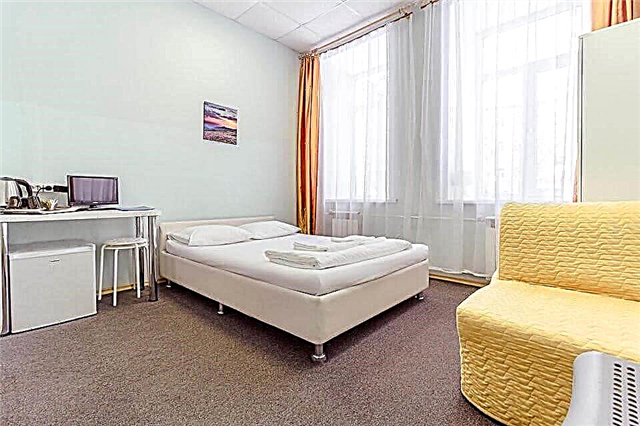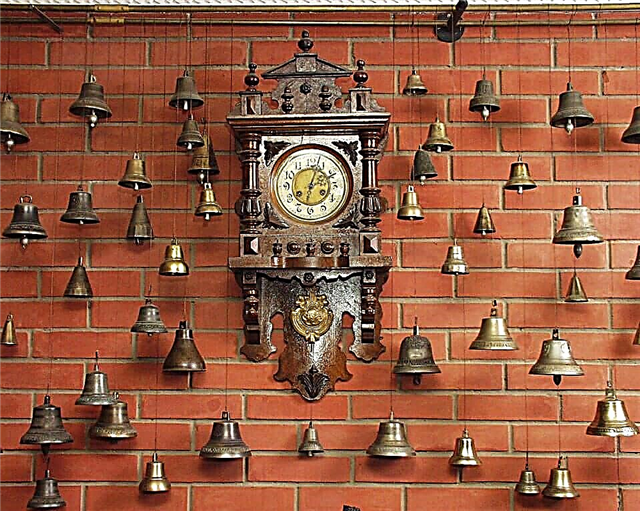Address: Russia, St. Petersburg, Kazanskaya square
Building: 1801 - 1811
Architect: Andrey Nikiforovich Voronikhin
Shrines: Miraculous list of the Kazan Icon of the Mother of God
Coordinates: 59 ° 56'03.0 "N 30 ° 19'28.0" E
Cultural heritage site of the Russian Federation
Content:
Cathedrals and churches of St. Petersburg cannot be imagined without the magnificent construction of the famous architect Andrei Nikiforovich Voronikhin. For more than two centuries, the Kazan Cathedral has become a real legend and turned into a temple-monument of military glory. Many pilgrims and tourists come to the slender suite of the cathedral every day.

Kazan Cathedral from a bird's eye view
Temple history
Since 1737, the baroque Christmas Church has stood in the center of the city. Inside a small court church there was a copy of the icon of Our Lady of Kazan revered by believers. At the court, a tradition has developed to celebrate the most significant military victories of the Russian army in this church.
Time passed, and the court church fell into decay. Its appearance did not in any way correspond to the ceremonial appearance of the representative Nevsky Prospect. At the end of the 18th century, the famous architects Nikolai Lvov and Giacomo Quarenghi prepared a project for the reconstruction of the building, but it was never carried out.
Under Paul I, they decided not to do alterations, but to build a new church. Moreover, the Russian sovereign wanted him to resemble the Roman Cathedral of St. Peter, famous throughout Europe. To implement an ambitious project, a competition was held and a project of an architect who was a serf of the influential Count Alexander Stroganov was chosen.

Young Andrei Voronikhin showed great promise, so no one doubted that he would be able to cope with a difficult task. Count Stroganov himself headed the board of trustees, which was supposed to deal with all issues of construction. Voronikhin had to take into account the wishes of the emperor and at the same time not deviate from the canons adopted in the Russian Orthodox Church.
To clear the construction site, 11 residential buildings were demolished on Nevsky Prospekt. The huge temple was erected for 10 years. In 1811 he received the first believers.
4.7 million rubles were spent on materials and work, and the talented architect was awarded an order and a life pension. The priests who were appointed to serve in the church were settled in a house at the intersection of Kazanskaya Street and Nevsky Prospekt.
Russian emperors showed special respect for the new cathedral. Alexander I took part in its laying and received from Stroganov the keys to the finished church. Inside the building, there was a special place for the royal people and their family members.

The decoration of the temple was carried out until 1829. All works were supervised by an experienced master Auguste Montferrand. To decorate the interiors, the builders used gold, silver, rare wood species, Riga limestone, Serdobolsk granite and marble from Olonets. Until the end of the 19th century, major repairs were carried out in the temple twice, wall paintings and icons were restored.
Unfortunately, there were some tragedies. In 1913, when the whole country celebrated 300 years of the ruling dynasty, many believers came to the cathedral. A strong crush began on the steps at the entrance. Newspapers wrote that 34 people were killed. Residents of St. Petersburg considered this a bad sign. Rumors spread throughout the city that the reign of the Romanovs would soon come to an end, and four years later the unkind prophecies came true.
After the revolution, church valuables were confiscated in all Russian churches - expensive icons, salaries and liturgical utensils. During this action, a large church iconostasis disappeared without a trace, the manufacture of which took 640 kg of silver.

In the 1930s, an active anti-religious campaign was launched in the USSR. The old cathedral was closed to believers and turned into a museum. The exhibits of an anti-religious exhibition, originally created in the Winter Palace, were exhibited here.
The museum dedicated to the history of religion and atheism has existed in the cult building for almost 60 years. In 1991, the collections were moved to the former house of Count Sergei Yaguzhinsky at 14 Pochtamtskaya Street, and services were resumed in the church. A few years later, the cathedral received the status of the cathedral church of the diocese.
Architectural features
The famous cathedral was built in the tradition of the Empire style and is considered a real pearl of Russian architecture. At the beginning of the 19th century, this was the largest church in the country. The ceremonial temple rises 71.6 m above the ground. The high dome has a diameter of 17 m. It is curious that for its construction a solid wrought iron frame was used for the first time.

The width of the temple is 56.7 m, its length is 72.5 m, and the wings extend from the main building to the sides by 42.7 m. The building is very harmonious, and artists and photographers love to draw it. In 2011, a 25-ruble coin was issued depicting the slender Kazan Cathedral.
The four-row suite consists of 96 granite columns. They are so popular with tourists that during the high season it can be difficult to find a place to take pictures near the columns. The Roman colonnade closes the square in front of the cathedral, while in Russia it opens towards Nevsky Prospekt.
The elegant suite stretches along the city highway and retains the traditional location for churches from west to east. The entrance to the building is in the west, and the altar is in the east. Voronikhin decorated the ends of the colonnade with strict monumental porticoes. The gray facades are decorated with beautiful Pudozh stone, which was mined in the quarries of Gatchina.
The temple does not have a separate belfry. The architect did this on purpose so as not to violate the symmetry of the building. Several bells are located in the openings of the western wing of the cathedral.

Outside, the church is decorated with bronze sculptures depicting revered saints - John the Baptist, St. Vladimir, Alexander Nevsky, the Apostle Andrew and several scenes from Holy Scripture. Since 1837, in front of the columns there have been monuments to the commanders Mikhail Bogdanovich Barclay de Tolly and Mikhail Illarionovich Kutuzov.
Interior decoration
The interiors of the cathedral are striking in their splendor. Real masters of painting took part in the painting of the temple - Vladimir Borovikovsky, Fyodor Bruni, Karl Bryullov, Grigory Ugryumov, Orest Kiprensky and other outstanding artists.
Inside there are 56 monolithic pink columns, carved from beautiful Finnish granite. Each of them weighs 30 tons, has a height of 10.6 m and is decorated with an expressive gilded capital of the Corinthian order. In addition, two stone bas-reliefs on religious themes can be seen in the cathedral.

For more than two centuries here are the trophies and banners of the defeated armies taken by Russian soldiers. The cathedral contains the marshal's baton of the Napoleonic commander Davout and the keys to the conquered cities. After restoration, the silver iconostasis has been completely restored.
Heart of Kutuzov
Many come to the temple to honor the memory of Field Marshal Kutuzov and bow to his grave. The commander died during a military march on the roads of Silesia in April 1813. By personal decree of the tsar, the deceased was embalmed and transferred with honors to St. Petersburg. According to the Orthodox rite, Kutuzov was buried in the main cathedral of the city.
Time passed, and rumors spread among the Russians that only the body rests in the temple, and the field marshal's heart is in Silesia. It was buried by the commander's adjutant in the cemetery of the small village of Tillendorf, 3 km from Bunzlau. The reason for such conversations was the last words of the commander that after death his heart will forever remain with the Russian soldiers.

In 1933, when the cathedral was already a museum, a special commission opened the old crypt and drew up an act. The document indicated that bones, remnants of woven fabric and a silver vessel with an embalmed heart were found inside.
Useful information for visitors
Services are held every day. On weekdays - at 9:00 and 18:00, on Saturday and Sunday - 10:00 and 18:00.
There is a small picturesque park in front of the temple. In its center there is a granite fountain, which was transported here from the road leading to Tsarskoe Selo. Tourists like to relax on park benches, feed pigeons, admire blooming flower beds, neat trimmed bushes and a green lawn. Residents of the city love to make dates and business meetings in the park.

How to get there
The Cathedral stands at 2 Kazanskaya Square, within walking distance from the Nevsky Prospekt metro station. Many city buses and trolleybuses stop in front of the temple.











